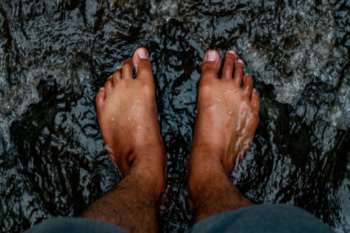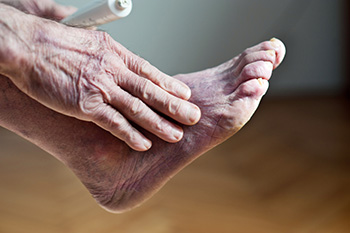Items filtered by date: November 2025
Finding Relief From Hammertoes

Hammertoes develop when one or more toe joints bend abnormally, causing the toe to curl downward instead of lying flat. Over time, this imbalance can make it painful to wear shoes or walk comfortably. Genetics, tight footwear, high heels, or muscle imbalance often contribute to the problem, which may start as flexible and later become rigid. Early treatment can help prevent progression and reduce discomfort. Conservative options include wearing shoes with roomy toe boxes, using custom orthotics, and performing gentle toe stretches to restore flexibility. Padding or splints can also ease pressure on the affected joints. In more advanced cases, a podiatrist may recommend minimally invasive surgery to realign the toe and restore natural movement. If your toes feel stiff, sore, or bent out of shape, it is suggested that you schedule an appointment with a podiatrist to discuss effective treatment options.
Hammertoes can be a painful condition to live with. For more information, contact Gregory Kranzusch, DPM of Foot and Ankle Center of St. Charles County. Our doctors will answer any of your foot- and ankle-related questions.
Hammertoe
Hammertoe is a foot deformity that occurs due to an imbalance in the muscles, tendons, or ligaments that normally hold the toe straight. It can be caused by the type of shoes you wear, your foot structure, trauma, and certain disease processes.
Symptoms
- Painful and/or difficult toe movement
- Swelling
- Joint stiffness
- Calluses/Corns
- Physical deformity
Risk Factors
- Age – The risk of hammertoe increases with age
- Sex – Women are more likely to have hammertoe compared to men
- Toe Length – You are more likely to develop hammertoe if your second toe is longer than your big toe
- Certain Diseases – Arthritis and diabetes may make you more likely to develop hammertoe
Treatment
If you have hammertoe, you should change into a more comfortable shoe that provides enough room for your toes. Exercises such as picking up marbles may strengthen and stretch your toe muscles. Nevertheless, it is important to seek assistance from a podiatrist in order to determine the severity of your hammertoe and see which treatment option will work best for you.
If you have any questions, please feel free to contact our office located in St. Charles, MO . We offer the newest diagnostic and treatment technologies for all your foot care needs.
Foot Alignment Problems in Children

As children grow, their feet and legs constantly change, sometimes leading to alignment problems such as inward or outward turning or flattened arches. These issues can result from differences in bone growth, muscle tightness, or ligament flexibility. Most mild cases improve with age, but some may cause pain, uneven gait, or frequent tripping, if not corrected. A podiatrist can determine whether the condition is part of normal development or needs treatment. Wearing supportive shoes, gentle stretching, and specially designed orthotics can help realign the feet and encourage healthy movement. In certain situations, targeted exercises or braces may be used to guide proper positioning as a child continues to grow. If you notice your child walking unevenly, stumbling often, or showing signs of discomfort, it is suggested that you have their feet evaluated by a podiatrist to ensure healthy development and alignment.
The health of a child’s feet is vital to their overall well-being. If you have any questions regarding foot health, contact Gregory Kranzusch, DPM of Foot and Ankle Center of St. Charles County. Our doctors can provide the care you need to keep you pain-free and on your feet.
Tips for Keeping Children's Feet Healthy
- Make sure their shoes fit properly
- Look for any signs of in-toeing or out-toeing
- Check to see if they have Clubfoot (condition that affects your child’s foot and ankle, twisting the heel and toes inward) which is one of the most common nonmajor birth defects.
- Lightly cover your baby’s feet (Tight covers may keep your baby from moving their feet freely, and could prevent normal development)
- Allow your toddler to go shoeless (Shoes can be restricting for a young child’s foot)
- Cut toenails straight across to avoid ingrown toenails
- Keep your child’s foot clean and dry
- Cover cuts and scrapes. Wash any scratches with soap and water and cover them with a bandage until they’ve healed.
If you have any questions, please feel free to contact our office located in St. Charles, MO . We offer the newest diagnostic and treatment technologies for all your foot care needs.
Feet That Tire Easily

Peripheral artery disease occurs when arteries that supply blood to the legs and feet become narrowed or blocked. This reduces oxygen flow and can cause leg pain, cramping, or fatigue when walking. Some people notice their feet feeling colder than usual or observe slow-healing sores on their legs or toes. Over time, poor circulation can increase the risk of infection and other serious complications. The condition often develops gradually, making early signs easy to overlook. However, paying attention to changes in your legs and feet can make a meaningful difference. A podiatrist can evaluate your circulation, perform noninvasive testing, and recommend treatments that restore blood flow and help prevent further damage. If your legs and feet ache or your feet appear discolored or cool to the touch, it is suggested that you schedule an appointment with a podiatrist who can offer effective relief and management tips.
Peripheral artery disease can pose a serious risk to your health. It can increase the risk of stroke and heart attack. If you have symptoms of peripheral artery disease, consult with Gregory Kranzusch, DPM from Foot and Ankle Center of St. Charles County. Our doctors will assess your condition and provide you with quality foot and ankle treatment.
Peripheral artery disease (PAD) is when arteries are constricted due to plaque (fatty deposits) build-up. This results in less blood flow to the legs and other extremities. The main cause of PAD is atherosclerosis, in which plaque builds up in the arteries.
Symptoms
Symptoms of PAD include:
- Claudication (leg pain from walking)
- Numbness in legs
- Decrease in growth of leg hair and toenails
- Paleness of the skin
- Erectile dysfunction
- Sores and wounds on legs and feet that won’t heal
- Coldness in one leg
It is important to note that a majority of individuals never show any symptoms of PAD.
Diagnosis
While PAD occurs in the legs and arteries, Podiatrists can diagnose PAD. Podiatrists utilize a test called an ankle-brachial index (ABI). An ABI test compares blood pressure in your arm to you ankle to see if any abnormality occurs. Ultrasound and imaging devices may also be used.
Treatment
Fortunately, lifestyle changes such as maintaining a healthy diet, exercising, managing cholesterol and blood sugar levels, and quitting smoking, can all treat PAD. Medications that prevent clots from occurring can be prescribed. Finally, in some cases, surgery may be recommended.
If you have any questions, please feel free to contact our office located in St. Charles, MO . We offer the newest diagnostic and treatment technologies for all your foot care needs.
